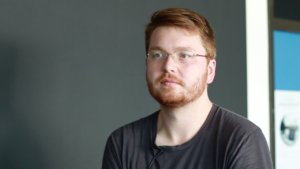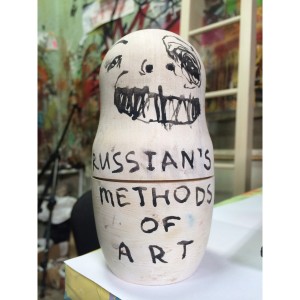The Audience is often very important to us. It is integrated in different ways. There are classical exhibitions. During the opening hours you go into the museum and you can see pictures or watch videos in galleries. You can buy something or not. You can consume it, appreciate it or dislike it, you can enrich yourself or get angry and you can leave. We also made theatre plays. There you have an audience that buys tickets and watches the play from 8 till 10 and goes home after. Then there are participatory structures. Some are intended and some unintended. Let`s take Mocmoc as an example: A whole population is involved. With a referendum, with their kids, who learn about it in school and perform a play. Once we get the kids, we have already won half the battle. And this is the reason why we developed Mocmoc together with the kids. On the basis of these manga figures, that we know from Asian countries. There is a bit of Disney in it and of course the Japanese manga culture. And certain parents from the left wing hated it of course, but the kids loved it! So we created this figure together, so that it would work out for them. With the kids as a partner. And those are strict partners. They can be very brutal. And from there we moved forward. The audience became a public audience and a media audience very quickly. With Bloch it’s a different audience. It’s funny for a lot of people, if two fellows with a tree trunk say: this is art. But they belong to our audience as well. The place, where art happens, in the production and presentation, changes from project to project. There are projects that are produced for the inner art market. Generally there is an exhibition in a gallery. You can buy something there – in a museum, an art gallery. There is an opening and closing date, there is a set up and a dismantling and in between something is presented. It can be the same thing every time, or it can change. When we exhibit in a gallery, there are some classic pictures, that are sold in order to finance our other projects, which swallow money. A project like Bloch is a real money-demolishing-machine. A transport from here (Germany) to China costs about 15.000 Euros. And NOBODY pays that for us. There are some sponsors and cultural institutes, that help, but we have to get the money from somewhere else. And that’s what we do, when we serve the classical art market. We try not to sell our souls there, as to say, we would not do it without the money. But there is an inner necessity of course, because we need the money. But we try to produce something that is meaningful, that makes us happy and something that we, ourselves, would hang on our walls. And then there are things, that take place outside of this art market context. For example when we drive into a Native American reserve. Maybe we take part in a festival. This does not have a lot to do with contemporary art. We will get in contact with flute carvers and dream tellers and shamans. That also does not have a lot to do with contemporary art. We bring it back. And this is under certain circumstances interesting for them, because they have a platform for their projects. Then there are processes or projects that run process-based in the museum. Before we started with Bloch, we worked with trees. Already in the post-ironic phase. And there we made two tree artworks. The first tree was an apple tree, that we dug out. Entirely, with all the roots. This is a long process. Our aim was to see: what is beneath it? So something quite obvious. A tree, we see everyday, when we go outside. But to have a look: What is beneath? The roots. To explore the roots of the tree, but also our own roots. And then we presented it as a natural ready made in the white cube. And we could have left it there, as a ready made or a sculpture. But then we said: okay, now we have to move on to the next stage. Now we start to work with this tree. And then we cut it during a performance into small pieces and gave them to the audience. Every piece had a number and left the museum, came into a new circle. And one of the collectors told me, that she had set her piece on fire. And another one told me: Yea, my dog plays with it. So it’s totally irrelevant. This tree or the pieces of this tree simply have a new life now.
Audience, also Publikum, ist bei uns sehr oft sehr wichtig. Also es wird verschieden integriert. Es gibt klassische Ausstellungen: Zu Öffnungszeiten geht man ins Museum und in Galerien kann man Bilder oder Videos angucken, kann etwas kaufen oder nicht, kann das konsumieren, gut finden oder schlecht finden, sich bereichern oder wütend werden und wieder gehen. Wir haben ja auch Theaterstücke gemacht, da gibt es eben das Publikum, das sich Karten für ein Stück kauft und das es sich anguckt von 20 bis 22Uhr und nach Hause geht. Dann gibt es partizipative Strukturen. Gewollte und ungewollte. Bei „Mocmoc“ zum Beispiel. Da wird eine Bevölkerung eingebunden. Via eine Abstimmung, via ihre Kinder, die das in der Schule durchnehmen, die ein Theater aufführen. Wenn wir die Kinder haben, ist das die halbe Miete. Und deswegen haben wir dann auch mit den Kindern zusammen „Mocmoc“ entwickelt. Auf Basis dieser Mangafiguren, wie wir sie kennen auch aus dem asiatischen Raum. Da schwingt Disney mit, da schwingt natürlich irgendwie japanische Mangakultur mit. Und das war natürlich für gewisse linke Eltern irgendwie ein Grauen aber die Kinder haben es geliebt. Wir haben also diese Figur mit ihnen entwickelt, dass sie für sie funktioniert. Mit ihnen als Partner. Und das sind strenge Partner. Die können auch ganz brutal sein. Und von da sind wir dann weiter gegangen. Dann wurde das Publikum sehr schnell auch ein öffentliches Publikum und ein Medienpublikum. Bei „Bloch“ ist das wieder ein anderes Publikum. Ist manchmal auch komisch für viele Leute, wenn da zwei Jungs mit einem Baumstamm kommen und sagen: das ist Kunst. Aber sie sind dann unser Publikum. Also sowohl in der Produktion wie auch in der Präsentation, vielleicht auch in der Rezeption: der Ort ändert sich von Projekt zu Projekt. Es gibt Projekte, die sind für den inneren Kunstbetrieb, auch Kunstmarkt, konzipiert. Da gibt es dann in der Regel eine Ausstellung in einer Galerie. Da kann man dann etwas kaufen. In einem Museum, in einer Kunsthalle, da gibt es einen Eröffnungstermin, da gibt es einen Endtermin, da gibt es einen Aufbau und einen Aufbau und da zwischen wird etwas gezeigt. Das kann immer das Selbe sein. Das kann sich aber auch verändern. Wenn wir in einer Galerie ausstellen, dann sind das zum Teil klassische Bilder, die verkauft werden, um unsere anderen Projekte quer zu finanzieren, die eben nur Geld verschlucken. Also ein Projekt wie „Bloch“ ist eigentlich eine gigantische Geldvernichtungsmaschine. Also ein Transport von hier (Deutschland) nach China braucht einfach mal 15.000€ oder so? Und das zahlt uns niemand. Also zum Teil sind das irgendwelche Sponsoren oder Kulturinstitutionen, die mithelfen aber wir müssen das Geld auch anderswo reinholen. Und das machen wir, indem wir manchmal klassisch den Kunstmarkt bedienen. Wir versuchen auch dort nicht nur uns zu verkaufen im Sinn von: Wir würden es nicht machen ohne Geld. Eine innere Notwendigkeit ist es natürlich, weil wir Geld brauchen aber wir versuchen auch da etwas Sinnvolles, das uns Freunde macht und das wir uns auch selber an die Wand hängen würden, zu produzieren. Und dann gibt es die Dinge, die ganz außerhalb dieses Kontextes Kunstbetrieb, oder im weitesten Sinne außerhalb, laufen. Beispielsweise, wenn wir in ein Indianer-Reservat fahren. Vielleicht nehmen wir dort an einem Festival Teil für Fiedler. Das hat per se wenig mit Zeitgenössischer Kunst zu tun. Wir werden da mit Flötenschnitzern und Traumerzählern und Schamanen zu tun haben. Das hat auch nicht so wahnsinnig viel mit dem Zeitgenössischen Kunstbetrieb zu tun. Wir bringen es dann wieder zurück. Und das ist dann auch für sie unter Umständen spannend, dass sie dann eine Plattform haben für ihre Projekte. Dann gibt es durchaus Prozesse bzw. Projekte, die im Museum prozessual ablaufen. Bevor wir „Bloch“ gemacht haben, haben wir begonnen mit Bäumen zu arbeiten. Schon in der Postironischen Phase. Und da haben wir zwei Baumarbeiten gemacht. Beim ersten Baum haben wir einen Apfelbaum ausgegraben. Mit samt allen Wurzeln. Das ist ein langer Prozess. Unser Ziel war da eigentlich zu sehen: Was liegt drunter? Also etwas ganz Naheliegendes. Ein Baum, den wir jeden Tag sehen, wenn wir raus sehen. Aber mal zu sehen: Was ist drunter? Also auch die Wurzeln. Unsere Wurzeln aber auch die Wurzeln des Baumes erforschen. Und das haben wir dann als quasi natural Readymade in den White Cube gestellt und das hätten wir auch so stehen lassen können als Fanal als Skulptur, als Readymade. Und dann haben wir aber gesagt: Okay, jetzt kommt der nächste Schritt. Jetzt arbeiten wir mit diesem Baum. Und wir haben dann in einer Schlussperformance diesen Baum rituell zersägt und haben das ans Publikum verteilt in kleinen Stücken. Jedes Stück hatte eine Nummerplakette und hat dann so den Museumsraum verlassen, ist dann wieder in einen weiteren Zyklus reingegangen. Und eine Sammlerin, die hat mir dann erzählt: Jaa, ich hab mein Stück verfeuert. Und eine andere hat gesagt: Jaa, mein Hund spielt damit. Also das ist völlig egal. Dieser Baum oder Stücke dieses Baums haben jetzt einfach wieder ein anderes Leben.

















